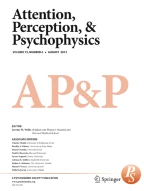Abstract
Previous studies have shown that interference from flanking distractors can be modulated by the object organization of the scene. The experiments reported here test for object-based attention under conditions of positional certainty, which allow a narrow focus of attention to the target. Prior research has suggested that object-based attention does not arise in these circumstances, but the experiments presented here show that object-based attention can still appear if previous experience with the stimuli leads participants to interpret the stimulus pattern as two separate objects. Two control experiments demonstrate that the appearance of object-based attention is not due simply to a widening of the focus of spatial attention. The presence of object-based attention in such a focused-attention task argues against Shomstein and Yantis’s (2002) proposed explanation of object-based attention based on priority in the order of visual search.
Article PDF
Similar content being viewed by others
Avoid common mistakes on your manuscript.
References
Atchley, P., &Kramer, A. F. (2001). Object and space-based attentional selection in three-dimensional space.Visual Cognition,8, 1–32.
Avrahami, J. (1999). Objects of attention, objects of perception.Perception & Psychophysics,61, 1604–1612.
Cave, K. R., &Zimmerman, J. M. (1997). Flexibility in spatial attention before and after practice.Psychological Science,8, 399–403.
Chen, Z. (1998). Switching attention within and between objects: The role of subjective organization.Canadian Journal of Experimental Psychology,52, 7–16.
Chen, Z., & Cave, K. R. (2006).Object-based attention is affected by time and experience and not by processing load or abrupt onsets. Manuscript in preparation.
Downing, C. J., &Pinker, S. (1985). The spatial structure of visual attention. In M. I. Posner & O. S. M. Marin (Eds.),Attention and performance XI (pp. 171–187). Hillsdale, NJ: Erlbaum.
Duncan, J. (1984). Selective attention and the organization of visual information.Journal of Experimental Psychology: General,113, 501–517.
Egly, R., Driver, J., &Rafal, R. D. (1994). Shifting visual attention between objects and locations: Evidence from normal and parietal lesion participants.Journal of Experimental Psychology: General,123, 501–517.
Eriksen, B. A., &Eriksen, C. W. (1974). Effects of noise letters upon the identification of a target letter in a nonsearch task.Perception & Psychophysics,16, 143–149.
Eriksen, C. W., &Hoffman, J. E. (1974). Selective attention: Noise suppression or signal enhancement?Bulletin of the Psychonomic Society,4, 587–589.
Eriksen, C. W., &St. James, J. D. (1986). Visual attention within and around the field of focal attention: A zoom lens model.Perception & Psychophysics,40, 225–240.
Garner, W. R. (1970). The stimulus in information processing.American Psychologist,25, 350–258.
Garner, W. R. (1974).The processing of information and structure. Hillsdale, NJ: Erlbaum.
Garner, W. R., &Felfoldy, G. L. (1970). Integrality of stimulus dimensions in various types of information processing.Cognitive Psychology,1, 225–241.
Goldsmith, M., &Yeari, M. (2003). Modulation of object-based attention by spatial focus under endogenous and exogenous orienting.Journal of Experimental Psychology: Human Perception & Performance,29, 897–918.
Gottwald, R. L., &Garner, W. R. (1975). Filtering and condensation tasks with integral and separable dimensions.Perception & Psychophysics,18, 26–28.
Harms, L., &Bundesen, C. (1983). Color segregation and selective attention in a nonsearch task.Perception & Psychophysics,33, 11–19.
Kim, M.-S., &Cave, K. R. (1995). Spatial attention in visual search for features and feature conjunctions.Psychological Science,6, 376–380.
Kim, M.-S., &Cave, K. R. (1999). Top-down and bottom-up attentional control: On the nature of interference from a salient distractor.Perception & Psychophysics,61, 1009–1023.
Kim, M.-S., &Cave, K. R. (2001). Perceptual grouping via spatial selection in a focused-attention task.Vision Research,41, 611–624.
Kramer, A. F., &Jacobson, A. (1991). Perceptual organization and focused attention: The role of objects and proximity in visual processing.Perception & Psychophysics,50, 267–284.
Kramer, A. F., Weber, T. A., &Watson, S. E. (1997). Object-based attentional selection—Grouped arrays or spatially invariant representations? Comment on Vecera and Farah (1994).Journal of Experimental Psychology: General,126, 3–13.
LaBerge, D., &Brown, V. (1989). Theory of attentional operations in shape identification.Psychological Review,96, 101–124.
Posner, M. I., Snyder, C. R. R., &Davidson, B. J. (1980). Attention and the detection of signals.Journal of Experimental Psychology: General,109, 160–174.
Shomstein, S., &Yantis, S. (2002). Object-based attention: Sensory modulation or priority setting.Perception & Psychophysics,64, 41–51.
Vecera, S. P., &Farah, M. J. (1994). Does visual attention select objects or locations?Journal of Experimental Psychology: General,123, 316–320.
Watson, S. E., &Kramer, A. F. (1999). Object-based visual selective attention and perceptual organization.Perception & Psychophysics,61, 31–49.
Yantis, S. (1992). Multielement visual tracking: Attention and perceptual organization.Cognitive Psychology,24, 295–340.
Author information
Authors and Affiliations
Corresponding author
Additional information
This research was supported by Grant U6498 from the University of Canterbury to Z.C., and in part by a University of Canterbury Visiting Erskine Fellowship to K.R.C.
Rights and permissions
About this article
Cite this article
Chen, Z., Cave, K.R. Reinstating object-based attention under positional certainty: The importance of subjective parsing. Perception & Psychophysics 68, 992–1003 (2006). https://doi.org/10.3758/BF03193360
Received:
Accepted:
Issue Date:
DOI: https://doi.org/10.3758/BF03193360
